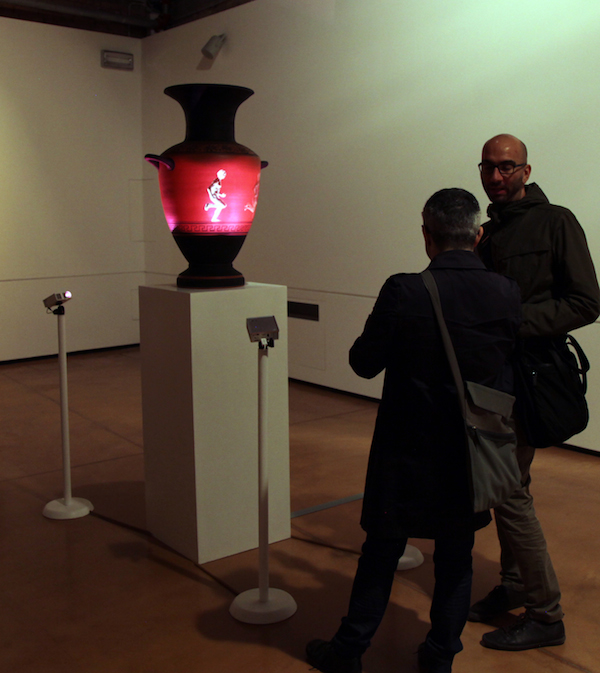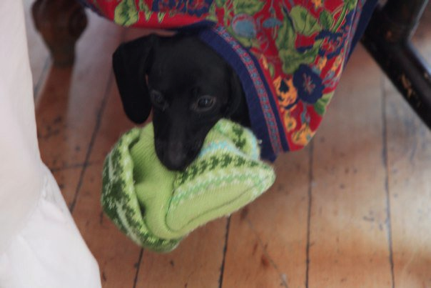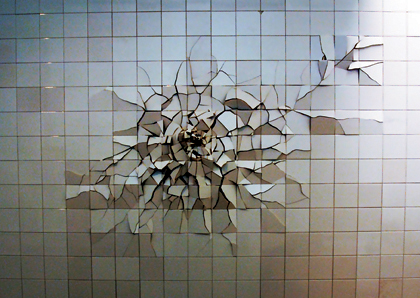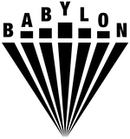
Capital of Nowhere gathers artworks together that envisioning a variable environments. In traditional societies, generations would come and go much faster than habitat would change. Catastrophes changed landscapes, be it natural or human in origin from volcano eruption to migration to asteroid to cultivation. In contemporary times, variety is introduced quickly into landscapes by prosperity or adversity. Over the last century, industrialization, urbanization, revolution, wars, construction and reconstruction – each lead to a generation living under conditions different than previous ones.
Exhibition
-
Clay vessels were made in Ancient Greece for multiple purposes. Placed on an agora, they were a receptacle for vine, grain or oil for sale. Installed over a grave, they played the part of a funerary monument. In city houses, various cylices, amphorae or phials had both the utilitarian and decorative functions.
But no matter what purpose they served, those vessels were always storytellers. There were stories depicted on them: scenes from the everyday life, tales of faraway cities or myths about gods and heroes. In the series “Made in Ancient Greece” by Anna Frants, classical vessels continue to tell stories by visual means, only, instead of black or red figures, the artists uses contemporary videos proving that an object from the past could be a great vehicle for a narrative about the present.
Ridiculing snobbishness of our conventional thinking, sculpture plays on principles of our vision, time that long term memory takes to pulls out cliches, and perfect proportions of the Greek pottery.
Video explanation of Made in Ancient GreeceWe see a multitude of multicolored socks alternatively glowing in the dark. Now one of them bursts into a bright light, now another, not having found a pair for itself… perhaps it is being chewed under the sofa…
The installation was created in memoriam of pets. Viewers are encouraged to bring photos of deceased pets for memorial wall. -
In their installation the artists tried to express the drama of a modern man. One is impossible to escape from a socially tightened mind. These rules and taboos are represented through the plastic bags put on the mannequin heads. This becomes symbo of liberty, equality and fraternity, the aesthetics and art, emotions and feelings. The person socially vaccinated in his childhood grows sluggish and hopelessly gray. Past, present and future stick together into a single chain of his external breathing, inhaling and exhaling. And it remains in sharp contrast with the grimace of choking person crying silently under the bag of time and society.

Installation by Elena Gubanova and Ivan Govorkov -
Two dozen furniture doors of various ages, styles and destinies were found by the artist at St. Petersburg dump sites and painted over. In a powerful, rough and light manner in three colors: white, black and red that refer to the aesthetics of a totalitarian poster, both Soviet and Italian. The subject of this painting is architecture: churches, towers, barracks, obelisks, triumphal arches...
Aggregated, they make up a city with a fanciful play of scales, backgrounds and silhouettes. This is neither St. Petersburg, nor Moscow, nor Rome as such – the contour of each building is simplified almost to a sign; it is impossible to identify it. This is the idea of power and glory expressed in architecture; an illusion of the Eternal City that is present in every capital city. It is not for nothing that the artist placed dignified silhouettes on the utensils that put in their time, which are ashes and... ashes to ashes.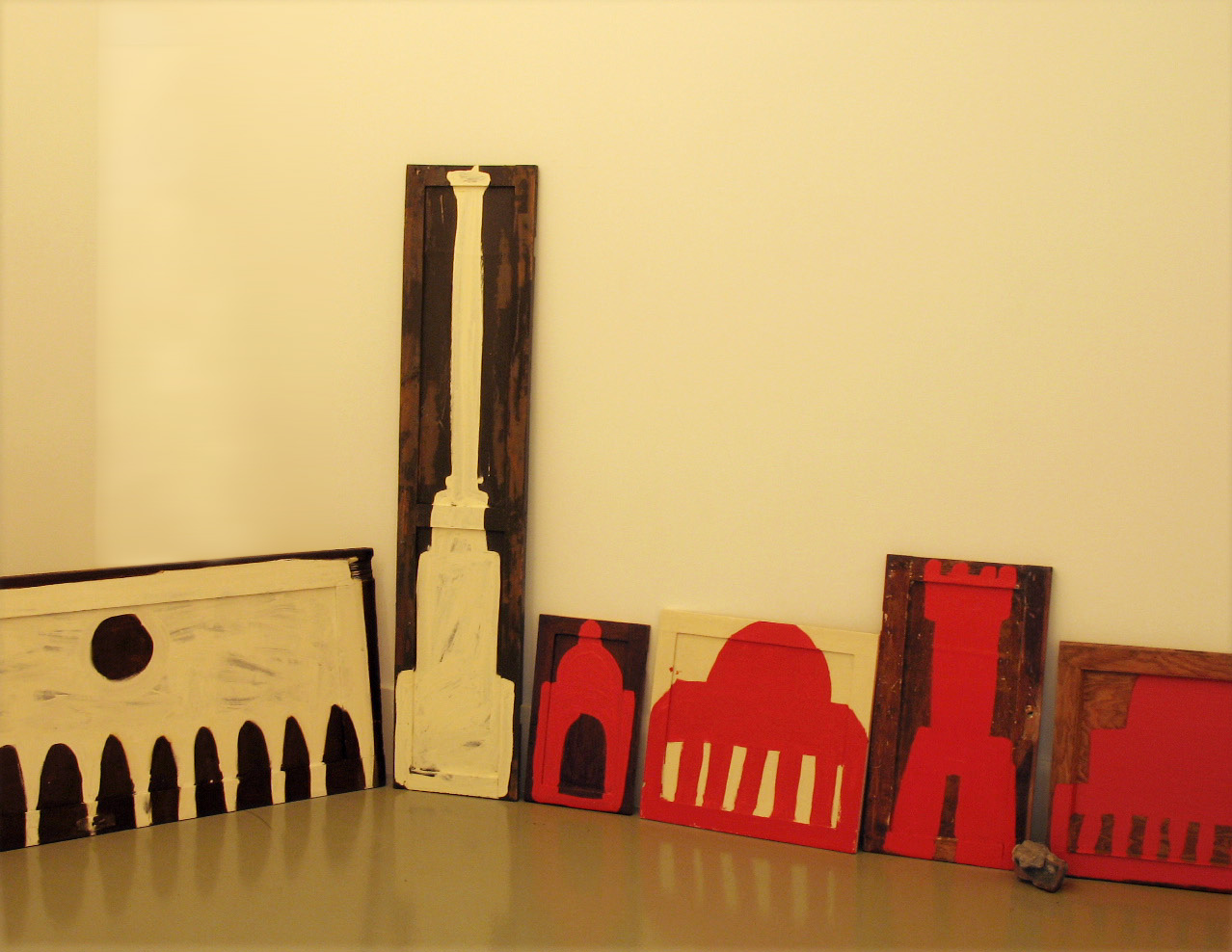
Installation by Marina KoldobskayaIn Variable Landscape projections replace each other in a slow mesmerizing rhythm: waves into spirals, stars into snowflakes, flowers into flies. Together these glowing elements create mysterious spaces: filled yet empty at the same time, like the land from the first days of creation.
Installation by Marina Koldobskaya -
Behind the figurative pictorialism of the subject, the plastic rhythm of columns and the composition of the work Waiting, there is literature with its philosophic emphases and reflections. And if earlier it was a question of the method of viewing an object and about imbuing it with meanings within the constraints of the Cartesian “I think, therefore I am”, in the work Waiting, the pictorial surface is built by layers: canvas, image, paper, video; the subject is put on as if on a skeleton; its materiality is emphasized; existence before thought. Video assigns a time vector to these layers and enlivens the static material existence with thought. Appealing to the evaluation of reality, the way it was done by Mamardashvili, Pushnitsky describes the world not as existing, but as transpiring.
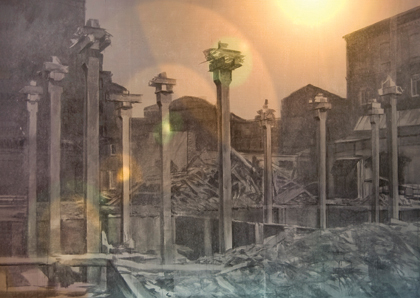
Media installation by Vitaly Pushnitsky -
The project Unnecessary Alphabet was created in 2007 and is part of the series ‘Memorial Model-making’. This reconstructed reality from the past, of basic Soviet advertising from the beginning of the seventies, is used here as an archaic symbol. In a wider sense, this is a project about a faint point of light in endless darkness, but not as a sign of hope of being saved, but rather as a symbol of total solitude. The artist turns backwards, trying to see the glimmering light of the irrevocably gone, the irreversible. Russian language, in which the sign is made, makes it inaccessible for the majority of viewers and thus emphasizes the individuality, deep personal nature and impenetrability for others of any memory.
-
A string of photo images is stretching to the music of Bach in the meditative video project Horizon Line by Alexandr Terebenin. Traces of paint and plaster on the peeling walls create dramatic landscapes – devoid of houses, trees or inhabitants, empty and formless places, the earth in the first (or last) days of creation.
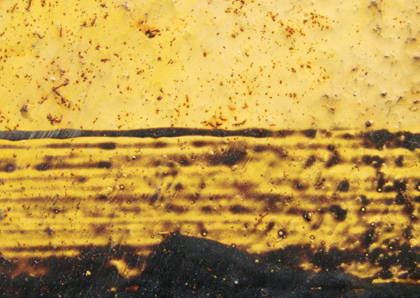
Video installation by Alexander Terebenin -
This video is about that, what a child (under 1 year old) can see, lying in a baby-carriage, which is moving through the town. Nobody knows exactly, what and in what way a child of that age can see. The video record was taken during the walk-imitation, when videocamera was put in a baby-carriage instead of a child.

Still from video installation by Ludmila Belova -
The title Tanya is selected by analogy with hurricanes that are given female names. By “exploding” a smooth white wall, Petr Shvetsov seems to detonate conventional meanings and stereotypes of the contemporary society by acting on behalf of an irrational elemental force capable of stamping everything out of existence. For him, it is enough just to denote this force, and the mechanism of destruction starts its work by breaking the wall’s monolith with a spider web of cracks – abstract minimalist lines. Shvetsov puts everything in its proper place by a brutal expressive gesture, showing ephemerality of the elusive wellbeing. The work with a plane is carried out as if unintentionally; the artist envisions the wall as if readymade. The natural aesthetics of simple things attracts him with its expressive texture that is capable of speaking “in the first person”, and this manifests an uncompromising nature of the author’s position.
-
Debris recalls anti-tank obstacle defence (also known as 'Gorikker hedgehogs' after their creator) in the shape of three-dimensional iron structures, widely used for protection during wartime).
The transformation of these brutal systems in glowing 'stars' serves as the perpetuation of the memory of the brilliant in their simplicity engineering decisions crucial at crysis. On the other hand, they are forever taken from the field of concrete historical memories to cultural archetypes.
Media installation by Pavel Ivanov and Alexey Grachev -
A sound installation by Andrii Linik consists of five robotic objects of simple shape that move and make sounds.
An existence, activity of these impenetrable black cube-shaped robotic organisms, that have «personality», «flesh» and «thinking», has become a metaphor for stopless selfconstitution, process of finding a consciousness, purpose for a life and meaning. That is embodied by their regular beats, sounds and movements or, other words, chanting of mantras, praying and searching own place or way to enlightenment.
Sound installation by Andrii Linik -
Movie Mincer was constructed by Russian media artist Sergey Teterin in 2004. An old soviet mincer is used as a laptop-connected device to manually generated video streams.
Movie mincer allows to show motion pictures by turning the mincer's handle reviving and paroding the atmosphere of the first performances from the very dawn of cinema era.
Movie Mincer regains much of cinematography's primary charm, fascination of rough and genuine illusion of «fast changing pictures». It produces «root» movie with frequency of shots 10-15 per second, creating true illusion of cinema, which is not available neither in modern cinema nore on DVD.
Media installation by Sergei Teterin -
First machines intimidated. A mass of inanimate metal, arranged in an inexplicable fashion, moved on its own, clanged, rattled, crushed and squashed. That thing, endowed with characteristics of a living being, did not have a common language with humans, and, while controlling it, its creator vaguely realized that his power over his creation was illusory. The revolt of machines overtaking of the planet by machines, doom of mankind – such grim fantasies were brought about by the view of a conveyor belt, a locomotive, a turbo, or a cannon. Approximately the same feelings are brought about by the protozoa. The point is not that they spray with venom, lash with stingers or entwine with flagella. We can do it as well. The point is that it is impossible to negotiate with them. The program that is built into them by nature, does not respond.
The authors of Protozoa deprived all displays, buttons or control panels – the communication adornments that give the user an illusion of control – and left the creator one on one with the tongueless creature.
Media installation by Anton Chumak
Visit Capital of Nowhere at The WYE (Berlin, Skalitzer Str. 86)
from November 13 to 17 2013
The WYE is an international art and technology hub spanning 2000 m2 of the historic Post building in the heart of Kreuzberg, Berlin. An incubator for local and international innovators, the space serves as a platform to elevate professionalism and exchange between the Art and Tech industries in Berlin. Opened in Fall of 2012, The WYE’s private studios, coworking and large event spaces have hosted cross disciplinary projects including Sound Development City, The Reader Awards, Seedcamp, Goethe Institute Mexico, Hardware Berlin, Kreuzberg Pavillon, Berlin Film Society, Berlin Fashion Week, Retune Festival and Service Design Berlin Conference among many others redefining the culture of innovation in Berlin.



